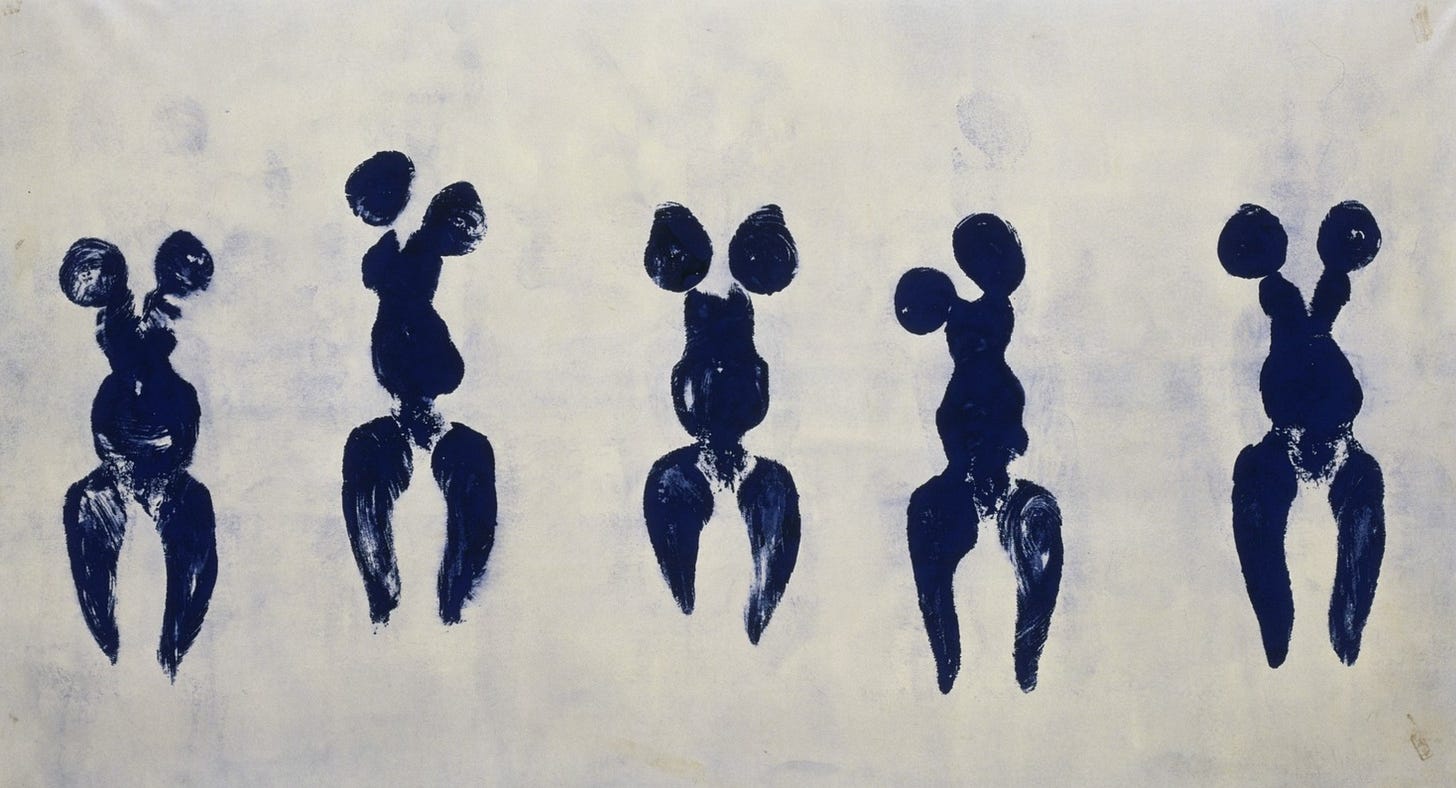A legend goes that Yves Klein saw the open sky at the beach in his youth and declared it his territory.
Klein was a French conceptual artist best known for his monochromes. Over a period of several years, Klein refined a pigment he called “International Klein Blue” or IKB. The deep, ultramarine color would go on to become emblematic of his work, eventually becoming the art itself when applied to sculpture, cards, and canvas.
I saw one of Klein’s blue monochromes at Le Centre Pompidou in France last year and found it hypnotizing. I must’ve looked like a bit of an idiot looking at a blue rectangle for 10 minutes, but there is something quite enveloping about it. I felt as if I was at once staring into that sublime sky or expanse of ocean:
[The men] were simply looking at the sky. In their eyes there was no vision: only the reflection of the blue and absolute skies of early autumn.. Those blue skies, though, were unusual skies such as I might never see again in my life: one moment strung up high aloft, the next plunged to the depths; constantly shifting, a strange compound of lucidity and madness.
– Yukio Mishima, Sun and Steel
Klein became a black belt judoka in Japan. There it is said he learned zen sensibility, which informs how sublime his work feels. Klein’s three monochrome colors he is most associated with are pink, gold, and blue. The pink represents the flesh, blue the sublime, and gold the passage into the immaterial. I see this as a non-dualist triad. The real, the unreal, and the passage between the two. They also reflect the Biblical trinity.
Klein’s most renowned series, Anthropométries, invites nude models to imprint their bodies on canvas using International Klein Blue. The use of human paintbrushes is demonstrative of Klein’s avant-garde approach, shattering artistry norms. The nude forme is perhaps the thing every artist paints. Partially out of a need to study anatomy, and partially, I feel, out of a sort of worship. For Klein to wield his models as brushes themselves: covering them in paint at once shatters and pays homage to this old artists’ tradition. In an especially peculiar move, he even patented the technique.
Just this year, Lévy Gorvy Dayan put on an exhibition of Klein’s work in New York, featuring more examples of the artist’s rebellious approach. Jessica Holmes’ review for The Brooklyn Rail reads:
A number of “Fire Paintings” from 1961–62 also hang in the show. Documented in another looping film, Klein made the works with a blowtorch, lighting canvases on fire that afterwards were immediately doused by a fireman. Nude models then pressed their bodies, sloshed with water, to these charred surfaces, leaving behind ashy shadow selves that seem to emanate from flame.
Klein also composed a ‘symphony’ that contradicts all conventional notions of what a symphony is. It’s an orchestral performance of a single D major chord for 20 minutes, followed by 20 minutes of silence. The monotone symphony to accompany his deeply still monochrome paintings. There is no abstraction. Klein wields pure pigment and pure sound (and silence).
The artist’s popularity and purported influence on modern art is not without controversy. Initially, Klein was scorned by critics, and today’s museumgoers often have strong emotional responses to his work. Klein’s controversy comes in how basic his work seems. Couldn’t any child dunk a canvas in blue paint? Isn’t using a woman’s naked body to paint a canvas plainly crude? People tend to find it repulsive. Certainly I can’t blame anyone for feeling this way - I felt much the same thing the first time. Still, the history of art must contend with his work. It’s easy to make fun of what he did. And yet he did it anyway.
A more generous interpretation of Klein’s work acknowledges that he challenged norm after norm after norm. He showed true creativity. He challenged observers to look into the sublime. He spent years obsessing over a pigment that he felt would have sufficient depth to envelop the watcher. Yves Klein would go on to be hugely influential in inspiring performance art, minimal art, and abstract art. He died of a heart attack at age 34 in 1962, just a few years after his most prolific period.
Meta:
I think often of emergence in art. How does the broad community of art, that amorphous network of reaction and neo-reaction, give rise to new genres, new concepts, new philosophies?
Sources:
Yves Klein and the Tangible World | Lévy Gorvy Dayan
Yves Klein - Editions & Works on Paper New York Tuesday, October 19, 2021 | Phillips
The only patented color ... or is it?
ChatGPT translation of the human paintbrushes technique patent (French patent)





